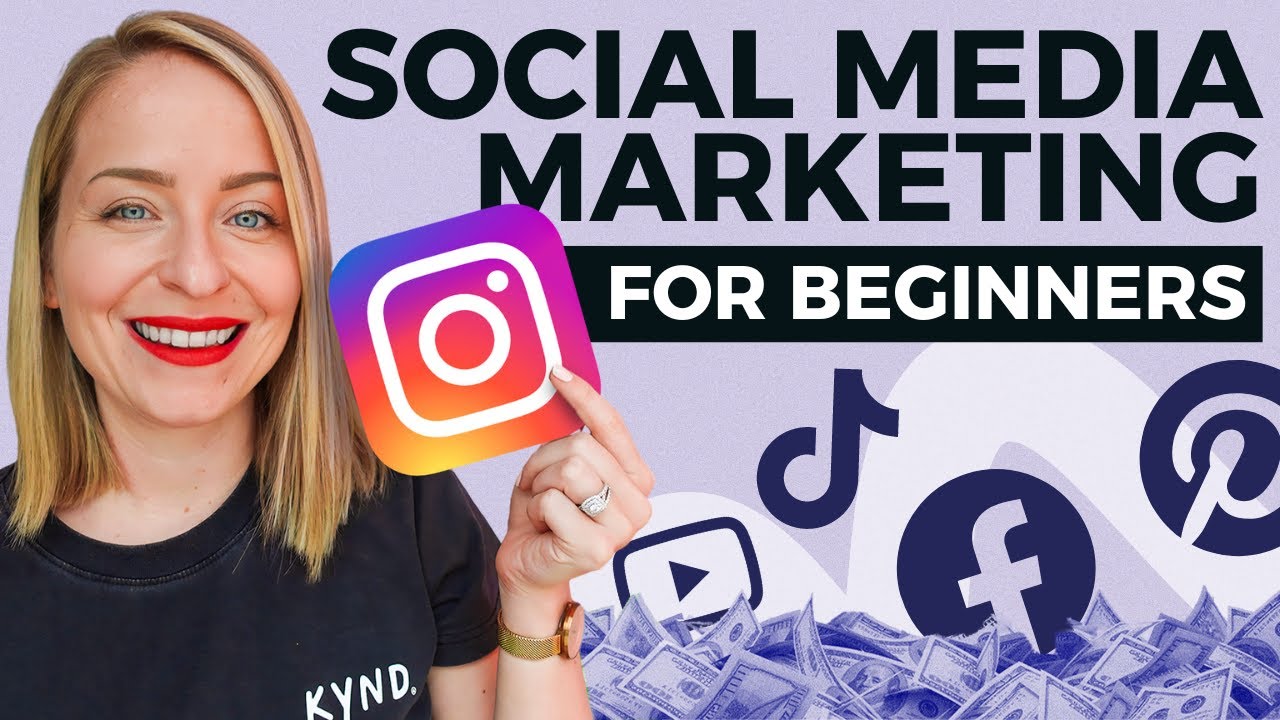Small Business Social Media Marketing - The Complete Beginner’s Guide For 2025
Social media has revolutionized how small businesses connect with their audience. It’s no longer just a space for personal updates; it’s a powerful tool for building brand awareness, driving sales, and fostering customer loyalty. For small businesses, social media levels the playing field, allowing you to compete with larger brands without a massive budget.
If you’re new to social media marketing, this guide is your roadmap. We’ll walk you through the essentials, from choosing the right platforms to crafting a strategy that delivers results. By the end, you’ll have the confidence and tools to start growing your business online.
What Is A Social Media Marketing Strategy?
A social media marketing strategy is a structured plan that outlines how a business will use social media platforms to achieve its marketing goals. It involves setting objectives, choosing the right platforms, creating engaging content, and measuring results to optimize performance.
Why Social Media Marketing Is Essential For Small Businesses
1. Cost-Effective Advertising
Unlike traditional advertising methods such as TV, radio, or print, social media marketing offers an affordable way for small businesses to reach their target audience. Platforms like Facebook, Instagram, and Twitter provide flexible advertising options that fit any budget.
For example, Facebook Ads allow businesses to set a daily budget as low as $5, ensuring that even small companies can run targeted campaigns. These ads can be customized based on audience demographics, interests, and behaviors, maximizing the chances of reaching the right people. Additionally, organic marketing posting engaging content without paid promotions offers businesses a way to increase visibility without spending a fortune.
2. Increased Brand Awareness
With billions of users active on social media every day, these platforms provide an unparalleled opportunity to get your brand noticed. Small businesses can establish a strong online presence by consistently posting valuable content and engaging with their audience.
Brand awareness goes beyond just recognition it’s about making your business memorable. The more a potential customer sees your brand in their feed, the more likely they are to trust and consider your products or services when making a purchasing decision. A well-maintained social media presence also helps businesses showcase their unique brand identity, allowing them to stand out in a crowded market.
3. Direct Customer Engagement
One of the biggest advantages of social media marketing is the ability to engage with customers directly. Unlike traditional marketing channels, which rely on one-way communication, social media enables real-time interaction. Businesses can respond to customer inquiries, address concerns, and even join conversations about their industry.
This direct engagement builds stronger relationships with customers, fostering trust and brand loyalty. When a business actively responds to comments and messages, it shows that they value their customers and are committed to providing excellent service. Positive interactions on social media can also encourage word-of-mouth marketing, as satisfied customers are more likely to share their experiences with others.
4. Data-Driven Insights For Better Decision-Making
Social media platforms offer powerful analytics tools that provide valuable insights into audience behavior and campaign performance. Businesses can track metrics such as engagement rates, reach, impressions, and conversion rates to determine what’s working and what needs improvement.
For instance, Instagram Insights and Facebook Analytics allow businesses to see which types of content generate the most engagement. By analyzing these metrics, small businesses can refine their social media strategies, focus on high-performing content, and adjust their approach to better meet customer needs. Data-driven marketing ensures that every effort put into social media delivers measurable results.
5. A Game-Changer For Small Businesses
Social media is more than just a marketing channel; it’s a business growth tool. It helps small businesses compete with larger brands by providing an accessible, cost-effective way to market their products and services. With the right strategy, social media can drive brand awareness, customer loyalty, and revenue growth, making it an essential component of any modern business plan.
For visual under understanding about social media marketing for your business, Watch this video:

Social Media Marketing for Beginners: Step-by-Step Plan
Facebook Marketing For Small Businesses
Facebook is one of the oldest and most widely used social media platforms, making it a valuable tool for small businesses. With over 1 billion daily users and more than 2 billion active users each month, it offers an excellent opportunity to connect with potential customers. If your target audience is on social media, chances are they’re on Facebook.
One of Facebook’s biggest advantages is its advanced advertising system, which allows businesses to target specific audiences. By analyzing engagement on your organic posts, Facebook can help you refine your ad targeting, ensuring your promotions reach the right people.
What To Post On Facebook
Facebook is a social platform where people expect engaging, informative, and sometimes entertaining content. When someone follows your business page, they’re likely looking for updates on promotions, new products, upcoming events, and special offers.
To keep your audience interested, experiment with different types of content and track what performs best. Popular content types include:
- Announcements and Updates:Share news about your business, such as product launches or changes in services.
- Promotions and Discounts:Highlight special deals and limited-time offers to encourage sales.
- Customer Stories and Testimonials:Showcase satisfied customers to build trust.
- Behind-the-Scenes Content:Give followers a glimpse of your business operations or team.
- Educational Posts:Share industry tips, how-to guides, and answers to frequently asked questions.
- User-Generated Content:Repost photos, videos, or reviews from happy customers.
- Interactive Posts:Use polls, quizzes, and live videos to boost engagement.
Once you identify which types of posts get the most likes, shares, and comments, focus on creating more of that content.
How Often To Post On Facebook
There is no strict rule on how often a business should post on Facebook, but finding the right balance is crucial. Posting too often can overwhelm your followers, while posting too little may cause them to forget about your brand.
A study by Socialbakers found that businesses that post more than twice a day see a drop in engagement per post. Similarly, businesses that post only once a week struggle to maintain an active presence.
A good rule of thumb is to post once a day or at least a few times per week. However, the key is quality over quantity; ensure every post provides value and resonates with your audience.
Tips To Increase Engagement
Facebook is a mix of personal and business content, meaning your posts will appear alongside family updates, pet photos, and viral videos. To stand out without being too promotional, keep your posts casual, relatable, and engaging.
Here are a few ways to boost engagement:
- Use a Conversational Tone:Write captions that feel natural and encourage discussion.
- Incorporate Humor:Lighthearted posts, jokes, and relatable memes can make your brand more approachable.
- Ask Questions:Encourage followers to comment by asking their opinions on trends, products, or experiences.
- Post at Optimal Times:Use Facebook Insights to determine when your audience is most active and schedule posts accordingly.
- Use High-Quality Visuals:Eye-catching images and videos are more likely to grab attention in crowded feeds.
- Respond to Comments and Messages:Engaging with your audience makes them feel valued and encourages further interaction.
Tip:Your followers chose to support your business for a reason. Keep your content relevant, interesting, and valuable so they stay engaged and connected with your brand.
LinkedIn Marketing For Small Businesses
LinkedIn is one of the oldest social media platforms, launched in 2002, and remains the go-to platform for professional networking. With over 250 million monthly active users, LinkedIn is especially valuable for business-to-business (B2B) marketing, with 94% of B2B marketers using it to share content.
If your business caters to professionals, industry leaders, or corporate clients, LinkedIn is an excellent place to build credibility, expand your network, and share valuable insights.
What To Post On LinkedIn
LinkedIn is a professional space where users look for business insights, industry trends, and networking opportunities. If someone follows your company page, they likely expect valuable knowledge, company updates, and thought leadership content.
Some content ideas for LinkedIn include:
- Industry Insights & Thought Leadership:Share expert opinions, research, and trends to establish your business as an authority.
- Company News & Achievements:Announce product launches, milestones, awards, or success stories.
- Educational Content:Provide tips, best practices, and in-depth guides relevant to your industry.
- Employee Spotlights & Company Culture:Highlight your team, workplace culture, or behind-the-scenes moments.
- Videos & Webinars:Engaging video content, such as product demonstrations or interviews with industry leaders, can boost engagement.
- Customer Testimonials & Case Studies:Showcase success stories that demonstrate the value of your products or services.
Tip:Videos perform especially well on LinkedIn. If you can create product or insight-focused videos, they can significantly boost engagement.
How Often To Post On LinkedIn
Posting at least once a week is ideal for maintaining a strong presence. Studies show that companies that post weekly on LinkedIn experience twice the engagement compared to those that post less frequently.
Additionally, LinkedIn provides a unique opportunity for employee advocacy. Encouraging your team members to share company updates and insights can help amplify your content’s reach without making your brand appear overly promotional.
Tips To Boost Engagement On LinkedIn
LinkedIn is a professional and knowledge-driven platform, so your content should be helpful, informative, and engaging. Here’s how to maximize engagement:
- Be a Resource:Share insights that help professionals grow and improve in their field.
- Encourage Employee Advocacy:Ask employees to share company updates to increase visibility.
- Use a Professional but Conversational Tone:Keep it informative but engaging, not overly formal.
- Engage with Comments and Messages:Responding to comments builds relationships and trust.
- Post at Optimal Times:Early mornings and midday (during work breaks) are the best times for engagement.
Twitter (X) Marketing For Small Businesses
Twitter is the most conversational and fast-paced social media platform. With over 500 million tweets sent daily and 320 million monthly active users, it’s a powerful tool for real-time engagement, brand awareness, and customer interaction.
Many businesses use Twitter to share news, interact with customers, and join industry discussions, making it one of the most effective platforms for immediate communication and engagement.
What To Post On Twitter
Twitter is designed for short, engaging, and interactive content. In 2017, Twitter expanded its character limit from 140 to 280, allowing businesses to share more details while maintaining Twitter’s quick, digestible format.
Here are some effective types of content to post on Twitter:
- Company Updates & Promotions:Announce new products, discounts, or upcoming events.
- Engaging Questions & Polls:Encourage audience participation by asking questions or running polls.
- Industry News & Trends:Share relevant news and your brand’s perspective on industry happenings.
- Customer Support & Engagement:Respond to customer inquiries and provide support directly.
- Humorous & Relatable Content:A lighthearted approach can help make your brand more relatable.
- Live Event Coverage:Tweet updates from events, conferences, or product launches in real time.
Since Twitter moves fast, real-time updates and trending discussions can help keep your brand relevant.
How Often To Post On Twitter
Because of Twitter’s fast-moving nature, businesses should post multiple times per day to stay visible. With over 5,787 tweets sent every second, posting frequently increases the chances of your tweets reaching your audience.
Most brands post at least 3-5 times a day, but you can adjust based on engagement levels and content availability.
Tips To Boost Engagement On Twitter
Twitter allows for a more casual and interactive brand presence compared to platforms like LinkedIn. To increase engagement:
- Keep Tweets Short & Impactful:Even with 280 characters, concise tweets perform better.
- Use Hashtags:Trending and industry-specific hashtags increase visibility.
- Engage in Conversations:Reply to mentions, retweet valuable content, and engage with followers.
- Use Images, GIFs, and Videos:Visual content stands out in a fast-moving feed.
- Run Contests & Giveaways:Encourage participation by offering incentives.
- Tweet at the Right Times:Early mornings, lunch breaks, and evenings tend to have the most engagement.
Unlike other platforms, Twitter allows businesses to be more playful and spontaneous. By maintaining an active presence and responding quickly, small businesses can use Twitter to build relationships, boost brand awareness, and stay connected with their audience.
Instagram Marketing For Small Businesses
Instagram is a highly visual platform with over 1 billion users, making it a great place for small businesses to showcase their products and brand personality. With 500 million daily active users, Instagram offers multiple ways to engage with audiences, including regular posts, Stories, and reels. Since Instagram is connected to Facebook, businesses can also run paid ads through Facebook’s ad system for better reach.
Many businesses use Instagram to highlight their brand visually, connect with their audience, and drive engagement through creative content.
What To Post On Instagram
Instagram content should be visually appealing and align with your brand identity. Businesses can share content in two main formats:
- Regular Posts:High-quality images, product showcases, customer testimonials, and promotional content.
- Instagram Stories:Short-lived (24-hour) updates, behind-the-scenes footage, polls, Q&A sessions, and product tags for direct shopping.
- Reels & Videos:Short, engaging videos demonstrating products, tutorials, or fun brand-related content.
- User-Generated Content (UGC):Share customer photos and testimonials to build trust and credibility.
Instagram’s mix of static images, videos, and temporary content allows businesses to creatively engage with their followers.
How Often To Post On Instagram
Consistency is key on Instagram. Posting frequently helps maintain engagement and keeps your brand relevant.
- Feed Posts:At least 3-4 times per week to maintain visibility.
- Stories:Daily updates help keep followers engaged.
- Reels & Videos:At least once a week to increase reach and interaction.
Brands should experiment with different posting schedules to see what resonates best with their audience.
Tips To Boost Engagement On Instagram
Instagram is all about creativity and interaction. To maximize engagement:
- Use High-Quality Visuals:Invest in good photography and design.
- Write Engaging Captions:Add personality and encourage conversation.
- Leverage Hashtags:Use a mix of trending and niche hashtags for discoverability.
- Encourage Interaction:Ask questions, create polls, and use Instagram’s interactive features.
- Post at Peak Times:Evenings and weekends tend to have higher engagement rates.
- Utilize Influencers & UGC:Partner with influencers or feature customer content to build credibility.
By consistently sharing visually appealing content and engaging with followers, small businesses can use Instagram to grow their brand and connect with potential customers.
YouTube Marketing For Small Businesses
YouTube is the world’s largest video platform, with 1.9 billion monthly active users and over a billion hours of video watched daily. As the second-largest search engine after Google, it’s an excellent tool for businesses to build credibility, educate their audience, and drive traffic.
Many businesses use YouTube for product tutorials, educational content, and brand storytelling to attract and engage potential customers.
What To Post On YouTube
YouTube content should be informative, engaging, and optimized for search. Popular video types include:
- How-To & Tutorials:Demonstrate how to use a product or solve a problem.
- Product Demonstrations & Reviews:Show features, benefits, and customer testimonials.
- Behind-the-Scenes Content:Share insights into your brand, team, and processes.
- Expert Interviews & Webinars:Position your brand as an industry authority.
- Storytelling & Brand Videos:Showcase your company’s mission, values, and customer success stories.
Since YouTube videos can have a longer shelf life than social media posts, businesses should focus on creating evergreen content that stays relevant over time.
How Often To Post On YouTube
Posting frequency depends on your business’s capacity to create high-quality videos. Some guidelines include:
- 1-2 videos per month:A good starting point for small businesses.
- Weekly uploads:Ideal for businesses focusing on content marketing.
- Consistent schedule:Helps maintain audience engagement and channel growth.
Quality is more important than quantity on YouTube, so focus on producing well-edited, informative videos.
Tips To Boost Engagement On YouTube
To increase views, subscribers, and engagement:
- Optimize for SEO:Use relevant keywords in titles, descriptions, and tags.
- Keep Videos Concise:2-5 minutes is ideal for most topics.
- Use Eye-Catching Thumbnails:A well-designed thumbnail increases click-through rates.
- Engage in Comments:Reply to viewers and encourage discussion.
- Include Calls to Action:Ask viewers to like, comment, share, or subscribe.
- Promote on Other Channels:Share videos on social media, email newsletters, and websites.
By creating valuable video content and optimizing for search, small businesses can use YouTube to reach a broader audience and build brand authority.
How To Create A Social Media Marketing Strategy In 9 Steps
1. Comprehensive Social Media Marketing Strategy
A strong social media marketing strategy is essential for businesses to build brand awareness, engage their target audience, and drive conversions. By carefully planning and implementing key tactics, brands can maximize their reach, engagement, and return on investment across different platforms.
2. Define Clear Objectives And Goals
Establishing clear and measurable goals is the foundation of an effective social media strategy. These goals should align with broader business objectives and follow the SMART framework, ensuring they are specific, measurable, achievable, relevant, and time-bound. Common objectives include increasing brand visibility, driving website traffic, generating leads, boosting customer engagement, and enhancing customer satisfaction.
3. Identify Target Audience And Buyer Personas
Understanding the target audience allows for the creation of tailored content and campaigns. Businesses should conduct in-depth research to define their ideal customer profiles, considering demographic factors such as age, gender, location, education level, and income. Psychographic insights, including interests, values, pain points, and online behavior, further refine marketing strategies. Analyzing audience preferences regarding social media platforms, content types, and engagement styles ensures more effective outreach.
3. Choose The Right Social Media Platforms
Selecting the most suitable social media platforms is crucial for optimizing engagement and maximizing marketing efforts. Facebook is ideal for community building, advertising, and diverse content formats, while Instagram excels in visual storytelling and influencer collaborations. X (formerly Twitter) is best suited for real-time updates and audience interaction, whereas LinkedIn serves B2B marketing, networking, and thought leadership. TikTok is highly effective for short-form videos, particularly among younger audiences, while Pinterest drives traffic through visually inspiring content, especially in lifestyle niches.
4. Develop A Content Strategy
A structured content strategy ensures consistency and meaningful engagement with the audience. Content should be diverse, including educational posts, promotional campaigns, interactive content, behind-the-scenes insights, user-generated material, and video content such as live streams and short-form reels. A well-planned content calendar is essential for maintaining a steady posting schedule, incorporating trending topics, and leveraging hashtags strategically.
5. Optimize Content For Engagement And Reach
Creating compelling captions and headlines enhances audience interest, while high-quality visuals and videos increase engagement. Using relevant hashtags improves discoverability, and active interaction with followers through comments, direct messages, and replies fosters a sense of community. Features such as polls, stories, and live sessions encourage participation, making the content more dynamic and appealing.
6. Implement Paid Advertising Strategies
Since organic reach is often limited, paid advertising plays a crucial role in expanding brand visibility. Facebook and Instagram ads offer targeted campaigns through carousel, video, and story formats. LinkedIn ads effectively promote B2B content, while YouTube ads leverage skippable and non-skippable video formats to reach a broader audience. TikTok and Pinterest ads drive engagement through creative short-form videos and shoppable content, helping businesses convert potential customers into loyal followers.
7. Monitor Performance And Adjust Strategies
Regularly tracking social media performance is essential for refining strategies and optimizing results. Metrics such as engagement rates, click-through rates, conversion rates, and audience demographics provide valuable insights. Analytics tools like Facebook Insights, Instagram Analytics, and Google Analytics help businesses measure the effectiveness of their campaigns. Adjusting content strategies based on data ensures continuous improvement and better alignment with audience preferences.
8. Foster Community Engagement And Brand Loyalty
Building an active and engaged community enhances brand loyalty and trust. Responding to comments, acknowledging customer feedback, and participating in conversations strengthen relationships with the audience. Collaborations with influencers, brand ambassadors, and loyal customers further amplify reach and credibility. Encouraging user-generated content and creating a personalized customer experience fosters long-term engagement, making the brand more relatable and trustworthy.
9. Stay Updated With Industry Trends
Social media trends evolve rapidly, and businesses must stay ahead by adapting to new features and algorithms. Keeping up with emerging trends, experimenting with new content formats, and embracing innovative marketing techniques ensure sustained relevance and competitiveness. Attending webinars, following industry experts, and analyzing competitors' strategies help brands remain agile and forward-thinking.
Creative Content Ideas To Stand Out
Capturing your audience’s attention requires unique and engaging content. By offering fresh perspectives and interactive experiences, brands can enhance their visibility and connect more meaningfully with their followers.
1. Showcase Behind-the-Scenes Moments
Giving your audience an inside look at your business adds a personal touch. Share photos or videos of your team at work, the creative process behind your products, or a day in the life of your employees. This humanizes your brand and builds a stronger connection with your audience.
2. Highlight Customer Testimonials And Success Stories
Positive reviews and real-life experiences help build credibility and trust. Share customer testimonials, case studies, or before-and-after transformations to demonstrate the value of your product or service. Featuring user-generated content can further strengthen community engagement.
3. Provide Educational And Informative Content
Position yourself as an industry expert by sharing useful insights. Create posts that offer tips, how-to guides, or solutions to common problems within your niche. Engaging formats such as carousel posts, infographics, and short explainer videos can make complex topics easier to understand.
4. Leverage Seasonal Promotions And Themed Content
Aligning your content with holidays, events, or trending topics keeps your brand relevant. Seasonal campaigns, limited-time offers, and festive-themed posts encourage higher engagement. Special giveaways or countdowns can also generate excitement among your audience.
5. Encourage Audience Interaction With Engaging Content
Interactive posts increase engagement and foster a sense of community. Polls, quizzes, and live Q&A sessions invite participation, while contests and giveaways encourage users to share and comment. Adding interactive elements to stories and reels can further enhance user involvement.
Example:A local bakery could share a time-lapse video of a cake being decorated, followed by a poll asking followers to vote on the next featured flavor. This not only engages the audience but also involves them in the decision-making process.
Essential Tools To Simplify Social Media Marketing
Managing social media efficiently requires the right tools to streamline processes, maintain consistency, and track performance.
1. Automate And Schedule Posts
Scheduling tools like Hootsuite and Buffer allow businesses to plan content in advance, ensuring a steady online presence without daily manual posting. Automation helps maintain consistency and frees up time for real-time engagement.
2. Create Professional Visuals With Ease
Graphic design tools such as Canva and Adobe Spark make it easy to design eye-catching posts, even without professional design experience. These platforms offer templates, fonts, and customizable elements that enhance content quality.
3. Analyze Performance With Data-Driven Insights
Tracking key metrics is crucial for optimizing social media efforts. Facebook Insights, Instagram Analytics, and Google Analytics provide valuable data on engagement, reach, and audience behavior, helping brands make informed decisions.
4. Find Trending Topics And Content Ideas
Staying relevant requires knowing what interests your audience. Tools like AnswerThePublic and BuzzSumo help identify trending topics, frequently asked questions, and popular industry discussions, allowing businesses to create timely and engaging content.
Pro Tip:Many of these tools offer free versions, making them accessible for small businesses looking to improve their social media presence without a significant financial investment.
Measuring Results And Refining Your Strategy
Regularly evaluating performance ensures that your social media efforts are effective and aligned with your business goals.
1. Track Key Performance Metrics
Monitoring essential metrics helps assess what’s working and what needs improvement. Focus on engagement rates, including likes, comments, and shares, as well as reach, impressions, website traffic, and conversions to measure overall impact.
2. Analyze Data For Deeper Insights
Using analytics tools to track performance trends can reveal patterns in audience behavior. Identifying top-performing posts, peak engagement times, and content preferences enables brands to refine their approach for better results.
3. Optimize Strategies For Ongoing Growth
Refining social media strategies based on performance insights is key to continuous improvement. Businesses should prioritize successful tactics, experiment with new content formats, and adjust posting schedules to maximize engagement.
Example:If Instagram Stories consistently generate more engagement than traditional posts, allocating more resources to creating interactive Stories can yield better results. Testing different styles, lengths, and interactive elements can further optimize engagement.
Proven Ways To Attract New Customers To Your Small Business
1. Optimize Your Website For SEO
A well-optimized website helps potential customers find your business online. Focus on using relevant keywords, creating high-quality content, and improving site speed. Search engines prioritize valuable, original content, so it’s important to ensure your material is engaging and free of AI-generated spam.
Using an AI content detectorcan help verify that your content meets search engine guidelines, maintaining authenticity and credibility. This improves your rankings and builds trust with your audience.
2. Offer Referral Incentives
Word-of-mouth marketing is one of the most effective ways to gain new customers. Encourage existing customers to refer their friends by offering discounts, free products, or exclusive rewards. A well-structured referral program can turn happy customers into brand ambassadors.
3. Collaborate With Other Businesses
Partnering with businesses that complement your offerings can introduce your brand to a new audience. For example, a gym could collaborate with a health food store to offer joint discounts. Cross-promotions, co-hosted events, and bundled deals can attract potential customers who may not have discovered your business otherwise.
4. Utilize Online Advertising
Investing in paid ads on Google, Facebook, or Instagram can drive targeted traffic to your business. By refining your ad targeting based on customer demographics, interests, and location, you can increase conversions. Running seasonal promotions or limited-time deals can make your ads even more compelling.
5. Host Events Or Workshops
Hosting in-person or online events, such as product demos, training sessions, or community gatherings, can help you establish authority and attract new customers. Events provide direct engagement opportunities, making your brand more memorable and trustworthy.
6. Implement A Customer Loyalty Program
Loyalty programs encourage repeat business and can also attract new customers. Offer points, discounts, or special perks to customers who make repeat purchases. Gamifying the experience through exclusive rewards can increase customer engagement and referrals.
7. Get Featured In Local Media
Getting press coverage in local newspapers, magazines, or blogs can significantly boost your business’s credibility and reach. Sending out press releases about new products, events, or milestones can help you gain media attention. Being featured on a popular podcast or online publication can also introduce your brand to a wider audience.
8. Engage In Community Involvement
Supporting local charities, sponsoring events, or participating in community initiatives helps build trust with potential customers. Businesses that actively give back to their communities tend to gain loyal customers who appreciate their contributions.
9. Enhance Your Customer Service
Excellent customer service can turn first-time buyers into repeat customers. Providing quick responses, personalized recommendations, and post-purchase support can leave a lasting impression. Satisfied customers are more likely to leave positive reviews and recommend your business to others.
10. Use Online Reviews To Your Advantage
Customer reviews influence buying decisions, so encourage satisfied customers to leave positive feedback on platforms like Google, Yelp, and Facebook. Responding to reviews both positive and negative shows that you value customer feedback and are committed to improving their experience. Displaying testimonials on your website and social media can further build trust.
11. Re-contact Old Customers
Sometimes, past customers need a simple reminder to return. Re-engage with inactive customers through personalized emails, special discounts, or exclusive deals. A simple "We Miss You" email with a limited-time offer can encourage repeat business.
12. Promote Your Expertise
Positioning yourself as an expert in your industry helps attract new customers and build trust. Share valuable insights through blog posts, guest articles, or speaking engagements. Creating high-quality content regularly can set you apart from competitors and keep your audience engaged. If you’re repurposing existing content or refining your messaging, using a paraphrasing toolcan help you rewrite text efficiently while maintaining clarity and originality.
People Also Ask
What Is The 50/30/20 Rule For Social Media?
The 50-30-20 rule recommends posting 50% engaging content, 30% curated content, and 20% promotional content. This balance keeps your target audience interested while promoting your brand across social media platforms effectively without overwhelming followers with sales messages.
How Do I Differentiate Between Owned And Paid Media?
Paid media is content you pay to place in front of an audience as an ad or sponsorship, while owned and earned are free. Owned media is content you create and control, like your Facebook page or your website, while earned media is content others create about you, like reviews or Instagram posts.
What Category Does Social Media Fall Under?
Although it's also considered owned media, social media can also fall into the earned media category depending on who is distributing the content and what is being shared.
Final Thoughts
Social media marketing is a powerful tool for small businesses, offering endless opportunities to connect with your audience and grow your brand. By choosing the right platforms, creating a solid strategy, and consistently engaging with your audience, you can achieve meaningful results.
Remember, success doesn’t happen overnight. Stay patient, keep experimenting, and don’t be afraid to ask for help. With dedication and the right approach, your small business can thrive in the world of social media.




